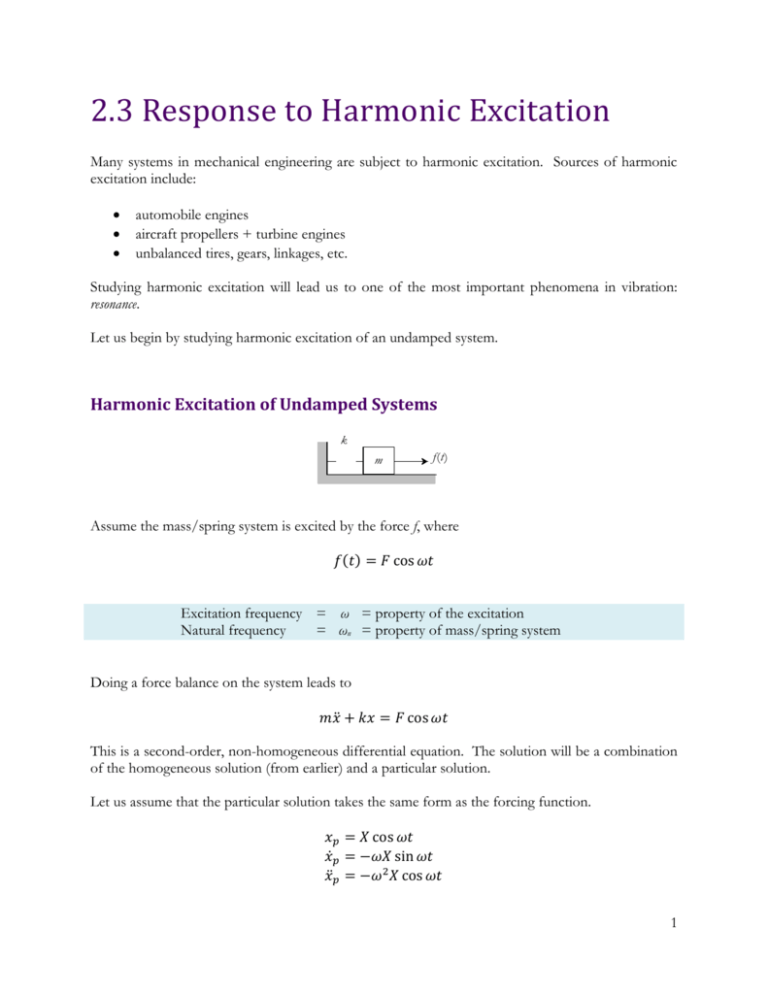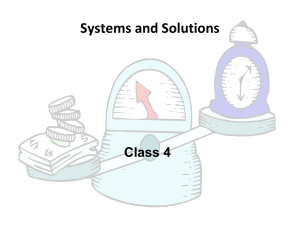Harmonic Excitation of Undamped Systems
advertisement

2.3 Response to Harmonic Excitation Many systems in mechanical engineering are subject to harmonic excitation. Sources of harmonic excitation include: automobile engines aircraft propellers + turbine engines unbalanced tires, gears, linkages, etc. Studying harmonic excitation will lead us to one of the most important phenomena in vibration: resonance. Let us begin by studying harmonic excitation of an undamped system. Harmonic Excitation of Undamped Systems k m f(t) Assume the mass/spring system is excited by the force f, where 𝑓(𝑡) = 𝐹 cos 𝜔𝑡 Excitation frequency = ω = property of the excitation Natural frequency = ωn = property of mass/spring system Doing a force balance on the system leads to 𝑚𝑥̈ + 𝑘𝑥 = 𝐹 cos 𝜔𝑡 This is a second-order, non-homogeneous differential equation. The solution will be a combination of the homogeneous solution (from earlier) and a particular solution. Let us assume that the particular solution takes the same form as the forcing function. 𝑥𝑝 = 𝑋 cos 𝜔𝑡 𝑥̇ 𝑝 = −𝜔𝑋 sin 𝜔𝑡 𝑥̈ 𝑝 = −𝜔2 𝑋 cos 𝜔𝑡 1 Substitute this into the equation of motion −𝑚𝜔2 𝑋 cos 𝜔𝑡 + 𝑘𝑋 cos 𝜔𝑡 = 𝐹 cos 𝜔𝑡 −𝑚𝜔2 𝑋 + 𝑘𝑋 = 𝐹 Divide through by m 𝑘 𝐹 𝑋= 𝑚 𝑚 𝐹 2 2 (𝜔𝑛 − 𝜔 )𝑋 = 𝑚 −𝜔2 𝑋 + Finally, solving for X 𝑋= 𝐹 𝑚(𝜔𝑛2 − 𝜔 2 ) 𝑥𝑝 = 𝐹 cos 𝜔𝑡 𝑚(𝜔𝑛2 − 𝜔 2 ) Thus, the particular solution is Now, let us rewrite the homogeneous part of the solution as 𝑥ℎ = 𝑎1 sin 𝜔𝑛 𝑡 + 𝑎2 cos 𝜔𝑛 𝑡 in the same way we did for Homework problem 1.7. Thus, the total solution is 𝑥 = 𝑥𝑝 + 𝑥ℎ 𝐹 cos 𝜔𝑡 = + 𝑎1 sin 𝜔𝑛 𝑡 + 𝑎2 cos 𝜔𝑛 𝑡 𝑚(𝜔𝑛2 − 𝜔 2 ) Taking the time derivative, we can find the velocity 𝑣= −𝜔𝐹 sin 𝜔𝑡 + 𝑎1 𝜔𝑛 cos 𝜔𝑛 𝑡 − 𝑎2 𝜔𝑛 sin 𝜔𝑛 𝑡 𝑚(𝜔𝑛2 − 𝜔 2 ) To find a1 and a2, we need to enforce the initial conditions. 𝑥(0) = 𝑥0 = 𝐹 + 𝑎2 − 𝜔2) 𝑚(𝜔𝑛2 Thus, 𝑎2 = 𝑥0 − 𝐹 − 𝜔2) 𝑚(𝜔𝑛2 2 also 𝑣(0) = 𝑣0 = 𝑎1 𝜔𝑛 thus 𝑎1 = 𝑣0 𝜔𝑛 The complete solution is then 𝑥= 𝐹 𝑣0 (cos 𝜔𝑡 − cos 𝜔 𝑡) + sin 𝜔𝑛 𝑡 + 𝑥0 cos 𝜔𝑛 𝑡 𝑛 𝑚(𝜔𝑛2 − 𝜔 2 ) 𝜔𝑛 Forced Response Initial conditions 3 Cases to Consider 1. The natural frequency is much greater than the excitation frequency. 0.4 0.2 x( t ) 0 0.2 0.4 0 2 4 6 t 1/f 8 10 1/f n 2. The excitation frequency is much greater than the natural frequency. 0.4 0.2 x( t ) 0 0.2 0.4 0 2 1/f 4 6 t 8 10 1/f n Both cases behave the same, even though the cause of the behavior is quite different! 4 3. The excitation frequency is close to (but not equal to) the natural frequency 4 2 x( t ) 0 2 4 0 5 10 15 20 t Here we see the phenomenon of “beating”. The angular frequency of the beats is seen to be 𝜔𝑏𝑒𝑎𝑡 = |𝜔𝑛 − 𝜔| 2 𝑓𝑏𝑒𝑎𝑡 = |𝜔𝑛 − 𝜔| 4𝜋 so that the frequency is Why is this? Let us assume for the moment that both initial conditions are zero. Then we are left with only the forced response: 𝑥= 𝐹 (cos 𝜔𝑡 − cos 𝜔𝑛 𝑡) − 𝜔2) 𝑚(𝜔𝑛2 Using a half-angle identity, we can write this as 𝑥= 2𝐹 𝜔𝑛 − 𝜔 𝜔𝑛 + 𝜔 sin ( 𝑡) sin ( 𝑡) 2 −𝜔 ) 2 2 𝑚(𝜔𝑛2 5 The first sine function provides a low-frequency “envelope” that contains the second, highfrequency sine function. The high-frequency component vibrates at the average of the excitation and natural frequencies. 4. The natural frequency is the same as the excitation frequency In the preceding equation, we note that as the two frequencies approach each other, the beat frequency becomes very low (the beats last longer) and the amplitude becomes large. |𝑥| = 2𝐹 →∞ 𝑚(𝜔𝑛2 − 𝜔 2 ) In the limit, as ω → ωn, the beat period is of infinite length and the magnitude increases without bound (or at least until the destruction of the system)! 20 10 x( t ) 0 10 20 0 2 4 6 8 10 t This phenomenon is known as “resonance”. If we drive a system at its natural frequency, we say we are driving it at resonance. Good resonance phenomena wind-driven musical instruments acoustic compressors thermoacoustic devices Bad resonance phenomena wind effects on buildings, bridges just about anything not related to music! 6








